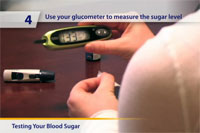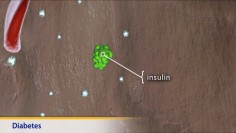
Diabetes: Self Blood Glucose Monitoring
Why do self blood glucose monitoring?
Self blood glucose monitoring is a way to measure the amount of glucose (sugar) in your blood. Measuring blood sugar levels at home has become a cornerstone of diabetes care. Measuring your child's blood sugar regularly can:
- help prevent low blood sugar at night
- reduce the risk of eye, kidney and nerve complications
- help you make informed decisions about the amount and type of insulin to use
- help you manage illness at home and alert you if you need to do a ketone test
- help you understand the effects of certain foods, exercise, and stress on your blood sugar.
What supplies are needed?
Doing a blood test requires a method of pricking the skin to get a drop of blood as well as a method of reading the results. Results are read using test strips that are put in a blood glucose meter.
Finger-pricking (lancing) device: A finger-pricking device (called a lancet) is used to get the drop of blood. The lancet can often be set at different depths for different people. The adjustable lancets are particularly good for young children who have tender skin and may not need much lancing depth. Remember to change the lancet every day. A sharp lancet helps prevent injury and infection.
Blood glucose meter: Most people use blood glucose meters to test their blood sugars. In some countries where meters are not available, color-changing blood sugar strips are used. Not all meters measure in the same way, so the results from different meters are not always comparable. It doesn't matter which type of meter you choose as long as you consistently use the same meter. Bring your meter to each clinic visit. Your provider will download the information from the meter to keep as a record.
Some features to look for in a meter include:
- Accuracy (Make sure the meter is accurate in the environment in which you live, for example, cold, heat, high humidity, or high altitude.)
- Storage of at least the last 100 test values
- Ability to be downloaded at clinic and/or at home
- Small size
- Short determination time
- Cleaning is easy or not necessary
- A control solution or strip can be used to check meter accuracy.
Test strips: When choosing test strips, make sure they work in the meter you are using. Look for strips that need only a small drop of blood and can draw the blood into the strip (capillary action). The glucose strips usually add up to a cost of $3 to $4 per day, so insurance coverage is important. Make sure you know what strips your insurance will pay for before you choose your meter.
How do I do a blood sugar test?
To get a drop of blood from a finger (or toe):
- Wash the area with warm water. This increases blood flow and makes sure there is nothing on the finger (or toe) that may alter the reading. Do not routinely wipe the finger with alcohol. Any trace of alcohol left on the skin will interfere with the test. Occasionally, when away from home (for example, camping and picnics), it is necessary to use alcohol-free travel wipes to clean the area.
- Air dry the area before pricking.
- Use the lancet to prick the side of the finger or toe rather than the fleshy pad on the fingertip or toe (which is more painful). It is often helpful to place the finger on a table. This helps prevent the natural reflex of withdrawing the finger when poked. If the drop is not coming easily, hold the hand down to the side of the body to increase the blood in the finger.
- Put the drop of blood on the strip. (If a test strip has been in a cooler or refrigerator, bring it to room temperature before using.) Make sure you completely cover the required area on the strip with blood. Putting too small a drop on the strip is one of the most common errors.
Do I have to prick a finger or toe?
Many children prick sites other than the fingers or toes because they may not hurt as much. The most common alternate site is the forearm. Other places to get blood include the fleshy part of the hand, upper arm, thigh, and back of the calf. The lancet must be dialed to the maximum depth to get enough blood from these sites. You would need a meter that works for these testing sites.
The main problem with not using the fingertips is that the blood flow through the arm is slower than through the fingers. The slower blood flow means the blood sugar value from the arm is 10 minutes behind the fingertip. It helps to rub the site to be used before pricking. Rubbing increases blood flow in the area. If your child is having symptoms of low blood sugar, use the fingertip.
When should my child do a blood sugar test?
Your child should do at least 3 or 4 blood sugar tests every day. The more often you measure your blood sugar level, the more information you and your diabetes care provider will have for making the right decisions about your child's diabetes management.
The most common times to do a blood sugar test include:
- Before breakfast: This test reflects the blood sugar values during the night and is probably the most important time to test. The rapid-acting insulin dose can be adjusted based, in part, by the value of this test. The dose of Lantus or Levemir insulin is also based on this test.
- Before lunch: This helps you decide if the morning Humalog/NovoLog/Apidra and/or Regular insulin dosage was correct.
- Before dinner: This test reflects how well the dose of morning NPH or lunchtime rapid-acting insulin worked. It may also reflect the effect of afternoon sports activities and an afternoon snack.
- Before the bedtime snack: This test lets you know if the rapid-acting insulin dose given at dinner was correct. This test is important for people who tend to have reactions during the night, children who play outside after dinner, and anyone who did not eat well at dinner. If the bedtime values are low, an extra snack should be given in addition to the usual solid protein and carbohydrate so your child's blood sugar does not drop too low during the night. Recheck the value 15 or more minutes after the snack to make sure that it has come back up.
Testing after meals: Doing a blood sugar test 2 hours after eating a meal is becoming a more common practice. You should check blood sugar values 2 hours after each meal once or twice weekly. The blood sugar value goals are the same for 2 hours after a meal as they are before a meal. Testing after meals is a useful testing time for people who count carbohydrates and inject insulin just before eating based on how many carbohydrates they plan to eat.
Testing at night: Occasionally, you may need to do a blood test in the middle of the night to make sure the value is not getting too low. A nighttime blood sugar test is important for people who tend to have low blood sugars during the night. More than half of the severe low sugars occur during the night. It is important to test on nights when there has been extra physical activity (for example, a basketball game in the evening or playing hard outside on a nice summer evening). The best time to do a check varies with each person. For some, between midnight and 2 AM is the best. For others, the early morning hours are better.
Testing at school: Some healthcare providers request that a test be done prior to eating lunch. For some children and schools this is not a problem and can be done without interfering with the child's normal school routine. If a low blood sugar reaction occurs at school or anywhere else, it is helpful for your child to do a blood sugar test at the time of the reaction.
What should the blood sugar level be?
The following table shows what the blood sugar level should be when you test. Bedtime blood sugar levels should be higher than other tests during the day so your child can get through the night without having a low blood sugar reaction.
Morning OR
2 hours before Before bedtime
Age (years) or after a meal snack
-----------------------------------------------------------
Birth to 6 100 to 180 mg/dl 100 to 210 mg/dl
*if below 80 mg/dl do
a test in the night
6 to 12 90 to 180 mg/dl 100 to 180 mg/dl
*if below 70 mg/dl do
a test in the night
13 to 18 90 to 130 mg/dl 90 to 150 mg/dl
*if below 60 mg/dl do
a test in the night
-------------------------------------------------------
Should I keep written records?
Keeping good records to look for patterns in blood sugars is essential. It is wise to keep written records even if your meter is able to store results (in case the meter breaks). Write down the time of the test, the date, how your child feels, and the blood sugar value. You may also want to note times of heavy exercise, illness, or stress. It may be helpful to record what was eaten for the bedtime snack or any evening exercise to see if these are related to morning blood sugars. Also, keep a record of when your child has low blood sugar reactions and possible causes. Bring these results to your appointments.
Good record keeping and bringing the results to clinic visits allow the family and diabetes team to work together most effectively to achieve good diabetes management.
What is continuous glucose monitoring (CGM)?
A CGM is a device that can record glucose readings every 1 to 10 minutes, day and night, for up to 7 days. The CGM sensor is placed under the skin. Alarms can be set for high and low glucose readings, can be tracked in real-time. CGM devices do not replace fingerstick monitors. Fingerstick measurements should still be taken at least 4 times per day and compared to the CGM readings to make sure that the CGM device is working properly.
In the future, CGM devices may replace frequent blood glucose tests that require pricking the skin. CGMs may also be linked with an insulin pump. This kind of system could constantly check blood sugar and give insulin as needed.
Last modified: 2012-01-31
Last reviewed: 2011-08-18


